Overview
Coatis are furry mammals that belong to the raccoon family Procyonidae and share some similarities with their raccoon cousins.
Both have long, bushy tails and black facial markings. Even their habitats are similar, with raccoons living in damp woodland areas and coatis inhabiting tropical forests and woodlands.
Although they have some similarities, they are far from identical. Coatis are social creatures that are active during the day, unlike the more solitary nocturnal raccoon. They also have prehensile noses that they use to hunt for food.
While most people are familiar with raccoons, not many have encountered a coati, so let’s unearth some fun facts about the coati species and get to know these furry critters a little better.
Is the Coatimundi the Same as a Coati?
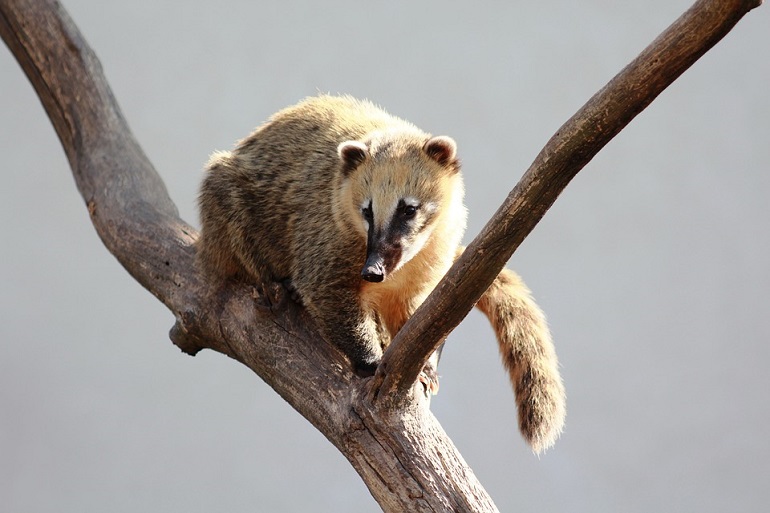
There is no difference between a coati and a coatimundi, but for many years scientists suspected that they were two separate species, with the larger, solitary coatimundi being distinct from the large groups of coatis they saw occupying forests and woodlands.
The solitary males were known as coatimundis, a word that means “lone coati” in the indigenous Brazilian language of Guarani, while groups of females and their offspring were called coatis.
Although the males and females share certain traits, you can understand how the difference in size made scientists think they were different species.
Fortunately, that confusion belongs to the past, and these days, the two names are used concurrently to describe any member of the coati species, regardless of gender or social behavior.
The Distribution and Habitat of the Coatimundi
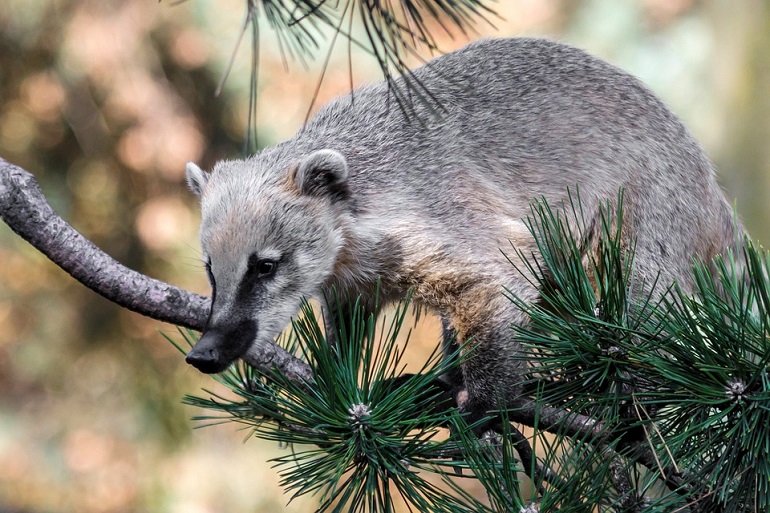
Coatis have a limited global distribution that’s restricted to North, Central, and South America. They occur as far north as Arizona with their geographical range extending through Mexico and into Uruguay. They also occur in northern Argentina and northwestern Colombia.
Although coatis are indigenous to this area, they pop up in some unusual places. According to a report by the BBC, in 2010, there was a group of around 10 coatis living wild in Cumbria in the northwest of England. Last year, a coati popped up in the Netherlands, nearly 9,000 km from its natural range!
These overseas coatis didn’t get there by themselves, but were presumably sold as pets and subsequently released.
The ones living in Cumbria prove just how adaptable this species is. Although they are most commonly found in forest habitats, they also inhabit the hills and canyons of southern Arizona and desert regions in northwestern Mexico. They can also survive in grasslands and wetlands.
The Taxonomy of the Coati and Its Link to Raccoons
The coati, also called coatimundi, belongs to the mammalian order, within which it is a member of the Carnivora family. All Carnivora species are descended from a common ancestor but then divided into cat-like creatures (feliformia) and those that more closely resemble dogs (caniformia).
Like raccoons, coatis belong to the second group because they have non-retractable claws and walk with their toes and metatarsal bones flat on the ground.
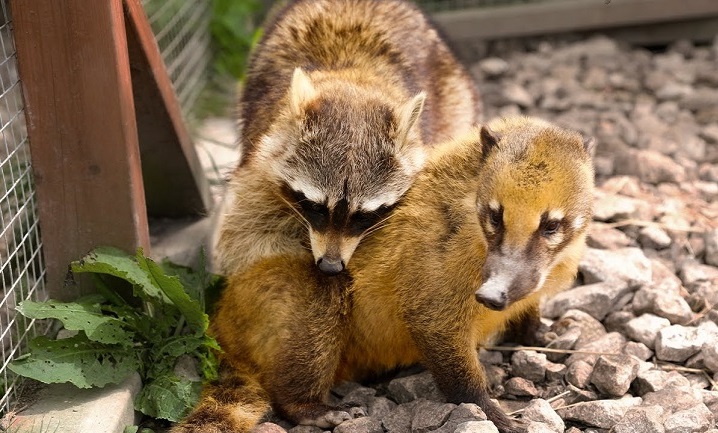
Both raccoons and coatis belong to the Procyonidae genus and are distinguished from other Caniformia genera by their dental structure.
Procyonids are tree-climbing mammals with 40 teeth, including long, sharp canines and broad, flat molars. This dentition indicates an omnivorous diet that includes everything from fruit and grains to small vertebrates.
Within the Procyonidae family, coatis fall into two separate genera. The two larger species, namely the White-nosed coati, or Nasua narica, and the South American coati (Nasua nasua) belong to the genus Nasua. Meanwhile, the smaller mountain coatis fall into the genus Nasuella.
Mountain ones are roughly half the size of common coatis and favor higher altitudes.
The Western mountain coati (Nasuella olivacea) lives in Colombia, Ecuador, and Western Venezuela, while the rare Eastern mountain coati (Nasuella meridensis) is only found in a few forests in the high mountain biome of Paramo.
What Do the Different Species of Coatis Look Like?
There are four different species of coatis, all of which share similar physical characteristics. Although the color of the coati’s coat varies, most are reddish brown or grey, with paler bellies, black facial markings, and rings on their tails.
All Coatis Have Long, Prehensile Noses and Tails
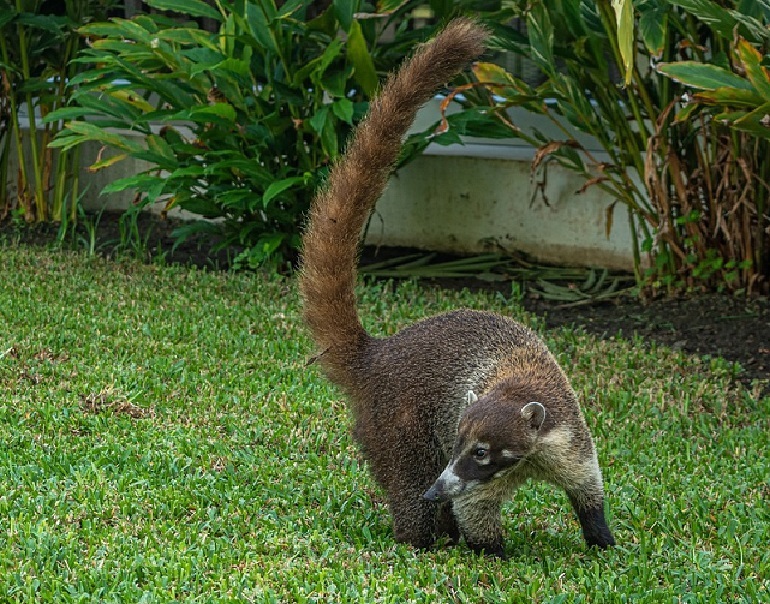
The coati’s tail is much longer than the raccoon’s and is similar to a monkey’s in that it’s capable of grasping things like tree branches and seizing objects by wrapping itself around them.
This prehensile tail makes the coati a better climber than the raccoon, helping it to keep its balance and maintain a firm grip on branches.
Coatis walk with an ambling gait similar to a bear. Raccoons also walk this way but don’t hold their tails up in the air as coatis do.
This trait is thought to act as a signal to other band members so they know where all their friends are foraging. Coatis also use their tails like a kickstand on a motorbike, helping them to balance when standing on their hind feet.
Coatis also have highly flexible noses that can rotate in all directions. This proves useful when most of your food is hiding in rock crevices or amongst the leaf litter on the forest floor.
Not only is the coati’s nose flexible, but it also turns up at the end, making it look a bit like a cute, furry pig and earning it the nickname “hog-nosed raccoon.”
Coatis Share Some Special Adaptations
The coati’s paws are very similar to a raccoon’s and have strong, non-retractable claws that they use for climbing and foraging for food.
One of the coati’s strangest physical attributes is that it has double-jointed ankles that can rotate over 180°. Raccoons have the same adaptation, and it enables both animals to descend from trees head first while maintaining a firm grip on the tree trunks.
All coatis have slender heads and powerful limbs that enable them to reach speeds of up to 27 km/h!
The Differences Between Common and Mountain Coatis
The two common coati species are relatively large, measuring around 66 to 67 inches long and standing around 11 to 12 inches tall at the shoulder. They are about the size of a domestic cat and almost twice that of the less common mountain coatis.
The smaller mountain coatis are more pocket-sized, measuring around 12 inches long and weighing between 1 to 1.5 kg.
You can tell the difference between the two species of coatis by the color of their noses. The South American coati has a dark grey or black nose and muzzle while the White-nosed coati is, as its name suggests, pure white!
It’s more challenging to distinguish between the two species of mountain coati because they share so many of the same characteristics. Both have gray or brown coats and bushy tails with dark bands, but the Eastern mountain coati is smaller, has a shorter tail, and has a dark dorsal stripe on its back.
The Coati’s Diet and Living Arrangements
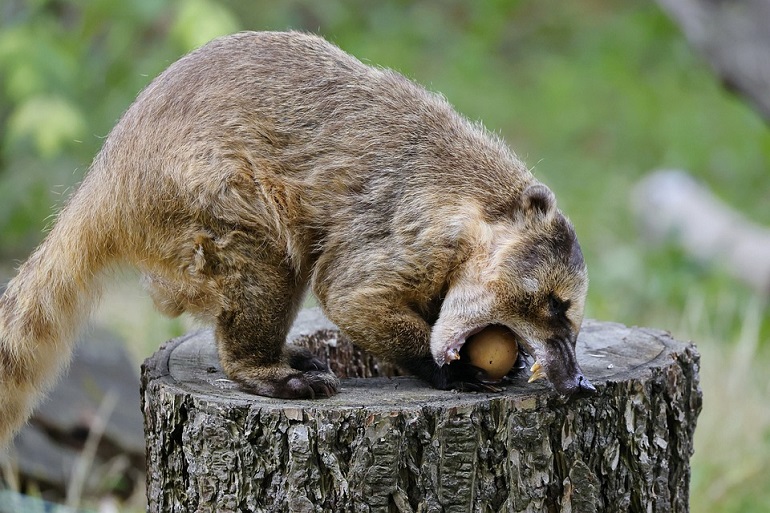
Coatis may be mammals, but they have one characteristic that’s more commonly associated with birds than other animals, which is that they build nests! Coatis build two types of nest – one for sleeping and a second, more sophisticated structure in which to give birth and raise young.
A study of coati nests in Brazil found that, like bird’s nests, they are constructed using branches, twigs, and woody vines, interlaced with leaves. They are usually built at heights of around 9.5 m and are around 30-50 cm³.
I can just imagine a band of coatis curled up in a nest together, all with their long noses tucked into their bellies, snoring gently!
Not only do coatis build nests like birds, but their diets are also pretty similar if a little more varied. Coatis are omnivorous and use their strong claws to dig through the leaf litter in search of beetles, lizards, rodents, and small vertebrates.
Their prehensile noses make them extremely adept at finding food, and they will investigate underground burrows and small crevices in search of a tasty morsel or two. If no prey is available, they are quite happy dining on fruit and nuts.
They mostly forage for food on the ground but will sometimes climb trees to hunt for birds and their eggs.
As male coatis forage alone, they have a better chance of catching rodents and lizards than adult females, which forage as a collective group.
The Social Life of the Coati
While females and their young coatis commonly live in groups called bands, the males are solitary and only join the bands for a short mating season that lasts around a month.
If male coatis attempt to approach the band at any other time, they will be chased away by several band members, including the dominant female and young coatis.
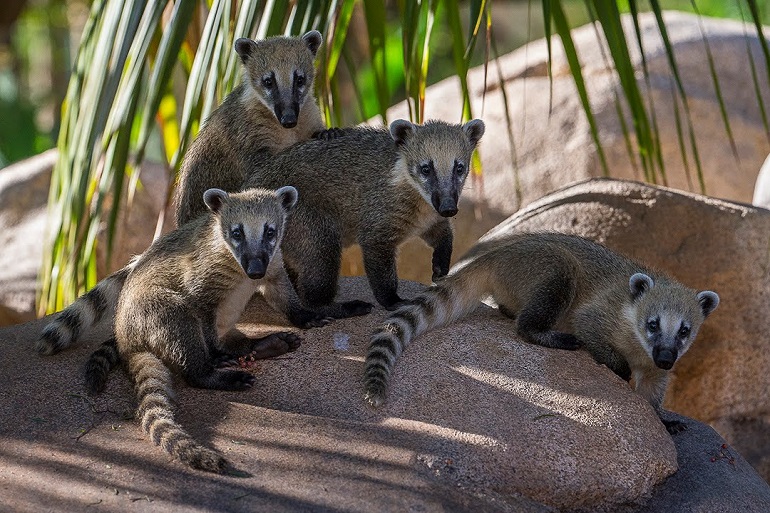
Female coatis are highly sociable and display a wide range of complex social behavior, including grooming and defending their territories. They even share nursing responsibilities, with some females foraging for food while others stay behind to babysit.
This behavior is known as reciprocal altruism and may even involve babies suckling from females other than their mothers.
While lone males are largely silent, the females use a wide range of communications to keep track of one another. They use barks to warn other coatis of potential danger, while whimpering sounds keep their babies close during the weaning period.
The Life Cycle and Expectancy of the Coati
Whether they’re lone males or sociable females, coatis don’t live very long in the wild, usually surviving to just seven years old. Coatis kept in captivity can live almost twice as long, with the average lifespan being around 10 years old and a few living to 14.
Fortunately, coatis mature at a very young age, with the females reaching sexual maturity by the time they’re 22 months old and their male counterparts being ready to breed before they turn three years old.
When sexually mature, a single male will join a band and mate with all the receptive members within their limited breeding season. The pregnant females then leave the band and start assembling their nursery nests, ready for the arrival of their offspring.
After a gestation period of three months, female coatis give birth to between two and seven kits or kittens, which suckle until they’re around four months old, before moving on to fruit and invertebrates.
The juveniles and females live together until the young reach the age of two years old, at which point the males leave to establish territories of their own.
What Are the Biggest Threats to the Coati?
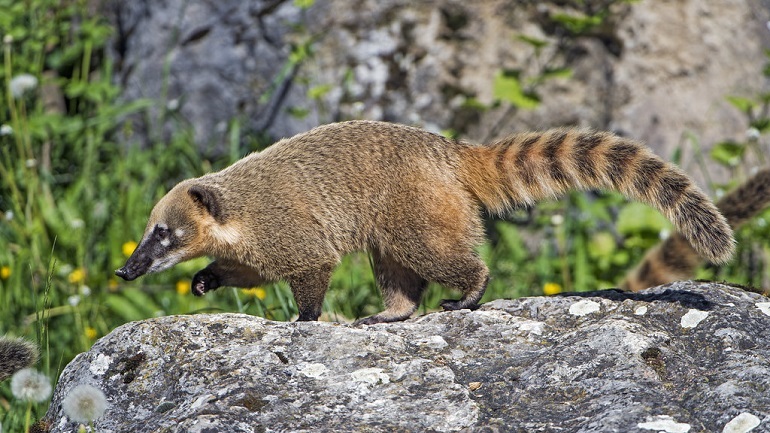
When snuggling in their nests, coatis are relatively safe, but when they descend from the trees to hunt, they face occasional predation from several species. Predators like jaguars and ocelots prey on coatis, as do birds of prey and large snakes.
Human Threats
Humans also take their toll on the coati population by hunting them and endangering their habitats. They are hunted for their fur and meat, and farmers also kill them to stop them from preying on chickens.
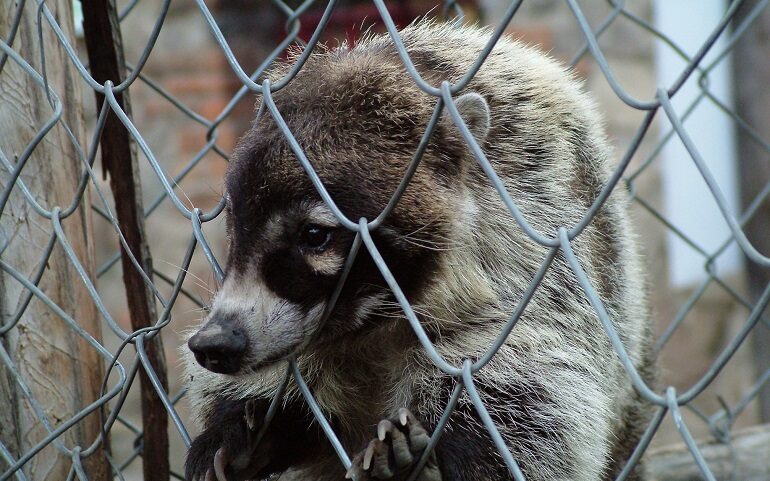
The demand for coati skins appears to be worldwide, and I even found a website advertising “trading post-grade” coatimundi skins for sale in the US!
Vehicle strikes and the illegal pet trade also put pressure on the coati’s existence.
Habitat Loss
None of these threats puts the coati at as much risk as habitat loss. Deforestation is rife throughout South America due to logging and agriculture. These activities have disturbed and degraded large parts of the forest ecosystem that coatis rely on.
Although researchers admit there is insufficient data available, they fear “it is probably threatened by habitat loss, hunting, and human-wildlife conflict.”
Are Coatis Vulnerable to Extinction?
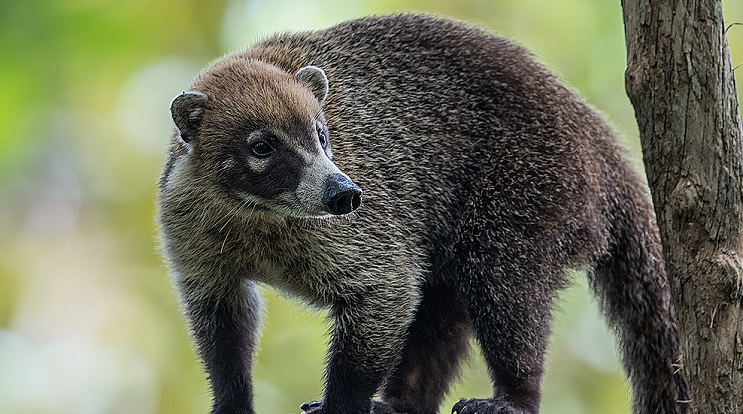
According to the International Union for Conservation of Nature (IUCN), the populations of all four species of coatis are in decline. South American and White-nosed coatis are listed as the least concern, which indicates that although locally threatened, it is not declining fast enough to be of great concern.
The two smaller species of coati aren’t so lucky, with the Western mountain coati being near threatened and the Eastern endangered.
Although the White-nosed coati is protected in New Mexico and listed on CITES Appendix III in Honduras, the more endangered species have been largely left to their own devices. As a result, we lack the information necessary to develop an effective conservation initiative.
Nevertheless, researchers suspect that “habitat loss and habitat conversion to agriculture” are harming the populations of both species of the Mountain coati.
Do Coatimundis Make Good Pets?
Coatis are extremely active, intelligent animals which makes them challenging to keep as pets. Because they live in groups, the females are particularly unsuited to domesticated life.
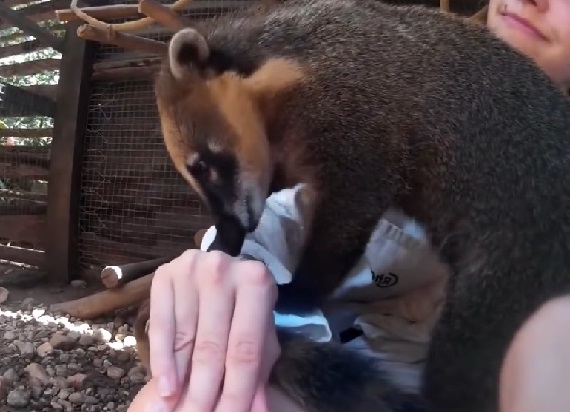
Not only do they establish lifelong social ties with others in the band, but they also have a larger brain size and substantially “larger relative frontal cortical volume than males.”
Coatis have complex behavioral, social, and psychological needs, which are difficult to fulfill in a domestic environment. They also have a lifelong curiosity which means living with one is a lot like living with a super smart toddler that never matures.
The coati’s agility and ability to climb also make it difficult to keep as a pet.
Three Fun Facts About Coatis
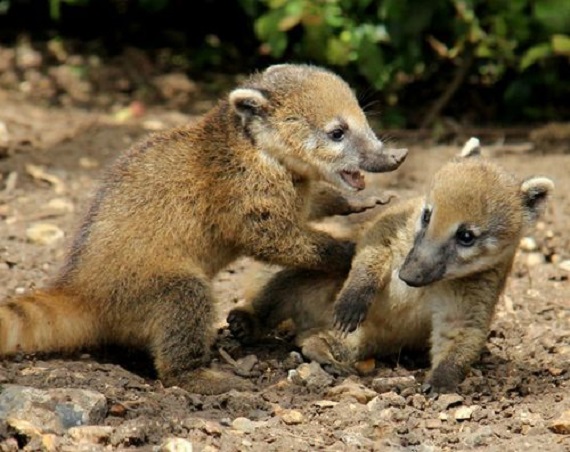
Below are three interesting facts about these amazing species.
#1 Coatis Love the High Life
Coatimundis can adapt to almost any habitat, including those far above sea level. The Eastern Mountain coati or Eastern Dwarf coati lives in cloud forests over 9,800 feet above sea level.
#2 Coatis Play a Critical Role in the Ecosystem
Coatis prey on beetles and other invertebrates, controlling their populations. They also disperse seeds when eating fruit, and aerate the soil with their long noses, enabling it to absorb nutrients and water more efficiently.
#3 Males Are More Nocturnal
While the females are diurnal, the solitary males are more active at night. According to experts at the San Diego Zoo, this behavior “allows adult males to minimize resource competition and maximize foraging efficiency.”
Conclusion
Coatis are entertaining, social animals that, like other wildlife, deserve our respect and protection. Keeping one as a pet might be tempting, but it’s not the best life for these highly active and sociable creatures.
The females are almost constantly active, socializing and finding enough food to keep the juveniles plum. They also establish lifelong social bonds with their friends and would be lonely if forced to live alone.
The solitary nature of males makes them more suited to life as a pet, but they become aggressive when they reach sexual maturity and may attack other pets and even their owners.
Although coatis have a high rate of reproduction and are relatively widespread within their range, numerous threats are causing their populations to decline.
The more we understand the life of the coati and appreciate its social and nutritional needs, the more capable we are of developing an effective way to conserve and protect these intriguing mammals.












